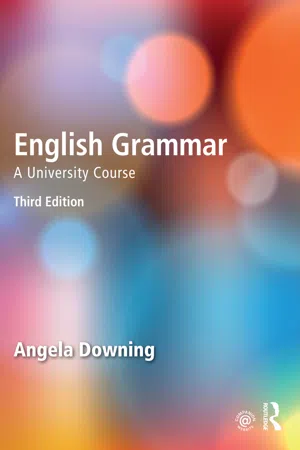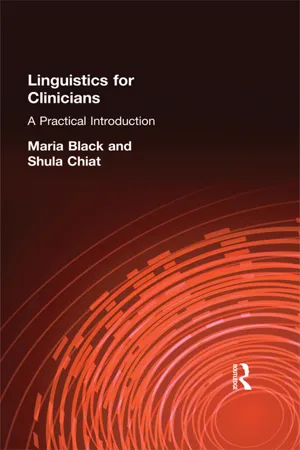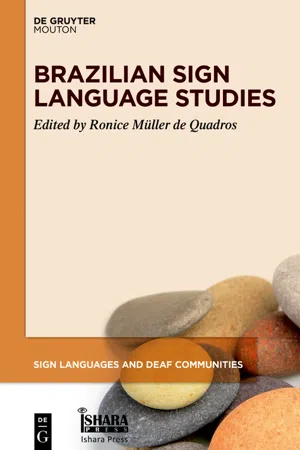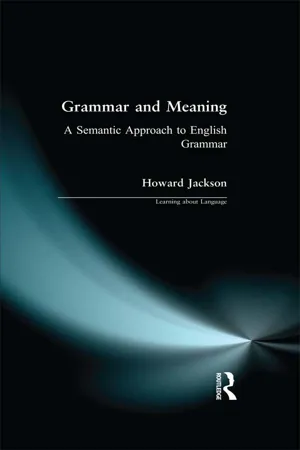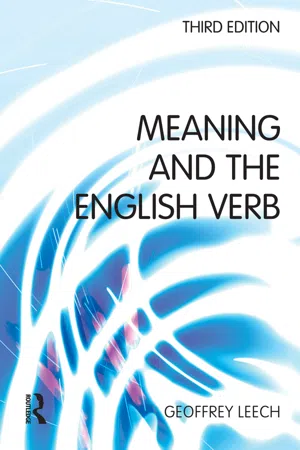Languages & Linguistics
Past Tense
Past tense refers to a grammatical form used to indicate that an action or state occurred in the past. In English, it is typically formed by adding "-ed" to the base form of a verb (e.g., "walked," "talked"). Different languages have various ways of expressing past tense, such as through verb conjugation or the use of specific markers.
Written by Perlego with AI-assistance
Related key terms
Related key terms
1 of 4
Related key terms
1 of 3
9 Key excerpts on "Past Tense"
- eBook - ePub
English Grammar
A University Course
- Angela Downing(Author)
- 2014(Publication Date)
- Routledge(Publisher)
- Tense is the grammatical expression of the location of events in time. It anchors an event to the speaker’s experience of the world by relating the event time to a point of reference. The universal, unmarked reference point is the moment of speaking – speech time. In narrative, a point in past time is usually taken as the reference point.
- English has two tenses, the present and the past, the past being the marked form, both morphologically and semantically.
- The basic meaning of the present tense is to locate a situation holding at the present moment. This may be an instantaneous event (I promise to wait), a permanent state, a fact held as true (The law of gravity is universal), or an habitual occurrence (He works in an office). Secondary meanings of the Present include reference to past and future events, ‘historic present’ (This man comes up to me . . . ) and the quotative (and she goes /she’s like ‘I don’t believe it’ ).
- The Past Tense primarily refers to a definite event or state that is prior to utterance time. Its secondary uses refer to a present event or state as hypothetical (If I were you ).
- English has no verbal inflection to mark a future tense. Instead, English makes use of a number of forms to refer to future events.
- Finite clauses in English can be marked for either tense or modality but not both. Verbs marked for tense are said to be ‘tensed’. Non-finite clauses are not tensed.
41.1 The Meaning of Tense
Tense is the grammatical expression of the location of events in time. It anchors (or ‘grounds’) an event to the speaker’s experience of the world by relating the event time to a point of reference. The normal, universal point of reference is the moment of speaking – speech time , what has been called ‘the inescapable and constantly changing now - Anand Syea(Author)
- 2023(Publication Date)
- Routledge(Publisher)
The present tense, for example, may be used to express not only a habitual event or a state happening in the present time (e.g. Mary drives to work) but also something happening in the future, as in Bill leaves for China on Tuesday, and the past, as when a speaker says I was in the pub last night and this bloke comes up to me to ask if I knew him. Past Tense, on the other hand, may be used to signal not only past time but also some pre-speech time situation(s) expressing counterfactuality as in I wondered if I could see you briefly this afternoon, If you had caught an early train, you would not have missed your flight or Don’t you think it’s time you went to school? These, however, can be viewed as extensions to the core meaning of the Past Tense, which is to signal past time. An adequate characterization of the concept of time requires us to be aware of the occurrence of an event in relation to a deictic point (i.e., whether it is contemporaneous, anterior or posterior to speech time) and also to a reference point. The contribution that a reference point makes in the understanding of tense and time can be appreciated when we consider a sentence with a verb in the past perfect such as When the phone rang, Mary had left the house or By noon, Mary had left the house. These sentences describe the event of leaving the house as having taken place in the past not only in relation to the moment of speech (i.e., prior to the moment of speech) but also in relation to the reference point (i.e., prior to the reference point): when the phone rang in the first example and by noon in the second example- eBook - ePub
- David Kilby(Author)
- 2019(Publication Date)
- Routledge(Publisher)
Chapter One Tense and Aspect The basic structural form of the English verb group is quite well known and poses few problems; furthermore, the details have been analysed many times in the literature (from virtually every theoretical perspective). We can analyse it as follows, omitting the specification of which suffixes are appropriate on the various elements: This formula begs certain questions: how are the suffixes specified? does the order of elements in the verb group need to be specified arbitrarily, or does it follow from more general principles? what is the categorial status of all of these elements? These are questions that have been beaten to death in the transformational literature, their major characteristic being that they bear on the types of grammatical device available in linguistic theory. I shall not be concerned with these questions, but rather with the meaning of these various options, and the problem of their compatibility with different verbs. There is a useful distinction to be made between 'tense' and 'aspect', both of which are found in English. Tense is a category which primarily involves the time of the event or state specified by the verb relative to the moment of utterance; aspect, on the other hand, is notoriously difficult to define: it is perhaps best to see it as focusing round such concepts as completion, repetition, habituality, etc. Look first at the category of tense in English: any of the positions marked 'suffix' in (1) are in principle available to be filled with a tense marker (which on the most regular of verbs corresponds to –0,– s or – ed). It is sometimes assumed that English has three tenses – past, present and future – but in fact there are only two relevant formal distinctions in English (–0 and – s are of course a single option, the difference between them not being a matter of tense, but rather the person and number of their subject noun phrase) - eBook - ePub
Linguistics for Clinicians
A Practical Introduction
- Maria Black, Shula Chiat(Authors)
- 2014(Publication Date)
- Routledge(Publisher)
What kind of time notions do such sentences express? When we think about time, we tend to think of it as one continuous line that we break up into past, present and future. Here I am, now: with time stretching behind and ahead of me:You might expect that time distinctions in language would directly reflect this three-way conceptual distinction, that the forms of language would correspond to these three times. But the way language frames time is not as simple as that. English, for example, has:- several forms for past situations, e.g. Rupert sent the e-mail Rupert has sent the e-mail Rupert had sent the e-mail
- two forms for present situations, e.g. Mary lives in Rome Mary is living in Rome
- many forms for future situations, e.g. I leave for Spain next week I’m going back soon I’m gonna watch that video later I will do my essay tomorrow I may do my essay tomorrow.
- The time of the situation relative to the utterance time (the time at which the sentence is produced).
- The time of the situation relative to a reference time (another time which is implicit in the context, or explicitly mentioned in the sentence).
- The time span of the situation relative to the utterance time or reference time.
These temporal characteristics determine our use of tense and the auxiliaries have and be. Tense indicates the timing of the situation (1 and 2 above). The auxiliaries have and be indicate its time span (3 above), conveying what is known as aspect. As we pointed out in Chapter 11 , the marking of tense and aspect is obligatory in English, forcing us to pay attention to the temporal relations that these express.Apart from the time distinctions that English requires, we have the option of adding reference times. These are conveyed by temporal modifiers such as now, yesterday, in 3 weeks, a year ago, yet, since I started the job.In this chapter, we explore these temporal meanings in more depth.12.2 Why look at time?
As we saw in the previous chapter, tense and auxiliary verbs are notoriously difficult for people whose language is impaired. Sometimes the timing of situations they are talking about can be worked out from the context, and it would be easy to think that missing out a Past Tense or an aspectual or modal verb does not matter much. But it may. Imagine an adult recounting their recent experiences in hospital, or their fears or hopes for the future. The timing of situations they are talking about matters to them, and difficulties with conveying time may leave them frustrated and their listener confused. It may then be important to look at the temporal meanings they want to express, and how we might facilitate this. - eBook - ePub
- Bas Aarts, April McMahon, Lars Hinrichs(Authors)
- 2020(Publication Date)
- Wiley-Blackwell(Publisher)
10 Tense in English LAURA A. MICHAELIS10.1 Introduction
Humans conceive of time in terms of space, as shown by the language that we use to talk about temporal relations: we habitually speak of stretching out or compressing an activity, heading toward the future, returning to the past, and so on (Whorf 1956 ; Lakoff and Johnson 1980 ; Binnick 1991 ; Chapter 1 , Casasanto and Boroditsky 2008 ). When describing the meanings of the tenses, linguists have relied on a specific instantiation of the space–time analogy: the TIMELINE . The timeline is a line (or, equivalently, an ordered set of points) that is unbounded at either end and segmented into three parts: the past, the present, and the future. While we can describe various ordering relations among points on the timeline (as when we describe two events as simultaneous), only one type of relation counts as a tense relation: that which includes the time at which the linguistic act is occurring. As Lyons states (1977, p. 682), “the crucial fact about tense […] is that it is a deictic category. A tensed proposition, therefore, will not merely be time‐bound, […] it will contain a reference to some point or period of time which cannot be identified except in terms of the zero‐point of the utterance.”Like other linguistic reference points that are anchored in the “here and now,” the temporal zero‐point can, under the appropriate conditions, be identified with times other than the time of speaking or writing. One such case is that in which a writer uses the time of message interpretation, rather than the time of message construction, as the zero‐point (Declerck 1991 , p. 15). For example, a note writer may choose the formulation I’m across the hall rather than I will be across the hall. The shifting of the temporal zero‐point also occurs in subordinate clauses, both temporal and conditional, as in, for example, When/if you have finished your test, [raise your hand]. Here, a present‐perfect predication is used despite the fact that its reference point is located in a (hypothetical) future rather than at the time of speaking (McCawley 1981 - eBook - ePub
Grammar, Meaning, and Concepts
A Discourse-Based Approach to English Grammar
- Susan Strauss, Parastou Feiz, Xuehua Xiang(Authors)
- 2018(Publication Date)
- Routledge(Publisher)
7 The Grammar of Time, Fact, Habit, Changeability, Permanence, Sequence, and Relevance in DiscourseTense and Aspect
Figure 7.1 “When you’re trying to fall asleep, does it ever feel like your thumbs are still texting?”© Randy Glasbergen. Reproduced with permission of Glasbergen Cartoon Service.In Chapter 6 , we discussed verbs and their functions and power in discourse. In this chapter, we introduce tense and aspect as features of grammar that infuse verbs with time reference and perspectival detail about states and events that verbs express.Tense relates to the time of a situation or event. In English, there are three categories of grammar that establish a broad frame of basic time reference—present tense, Past Tense, and future—but only present tense and Past Tense are formed with morphological inflections (see Chapter 2 ). Future time is expressed with the modal will (see Chapter 8 ).Aspect works within these temporal frames of time to provide additional detail revealing perspectives and viewpoints with respect to how those events, processes, and actions unfold; what relationship they have with their time of unfolding; and what relationship they have with other events and times within discourse (Bybee, 2008; Bybee et al., 1994; Comrie, 1976, 1985; Fenn, 1987; Hirtle, 1967; Hopper, 1982; Langacker, 2008; Leech, 1971; Radden & Dirven, 2007).There are four grammaticalized aspects in English: simple, progressive, perfect, and perfect progressive. These four aspects interact with the three tenses to create 12 combinations of tense and aspect forms. That is, grammatical aspect and tense are inextricably interrelated. Later, we will discuss the 12 possible tense and aspect categories for English in more detail. - eBook - ePub
- Ronice Müller de Quadros(Author)
- 2020(Publication Date)
- De Gruyter Mouton(Publisher)
To this end, this research develops an analysis to describe elements in the grammar system of Libras to denote tense and aspect – far more than just a short list of lexical items, as has been assumed so far for this language. Within the analysis, morphological inflections and compositional relations between tense and aspect show that such a system is much richer than expected. The data shown here is obviously just a sample of tense/aspect forms, and the examples were chosen for being the most recurrent among Libras speakers. Thus, the first section presents a set of examples analyzed in order to describe the parameters involved in the temporal reference system in Libras, regardless of any theoretical proposition for the tense category. In the second section though, a theoretical model is provided, along with a conceptual definition for the aspect category, and its organizational rules in Libras.2 Description of tense signs
Reichenbach’s (1947) works have been constantly revisited and reconstructed when it comes to tense category description in natural languages. In summary, his proposition poses a model based on three primitive temporal entities: S, the speech time, regarding the moment a sentence is uttered; E, the event time, referring to the time that the event which the sentence is about takes place; and R, the reference time. Thus, tense is still defined as a deictic category, since it establishes localization in time, taking the speech time as reference point.Klein (2007[1994]) revisits and widens Reichenbach’s model, by rearranging it into a description of how the tense category is organized. To clarify the concepts related to this new model, we have to consider that temporality may, as the author defends, be expressed in natural languages by: grammar inflections, tense characteristics that are inherent in the verbs and/or their complements, adverbs, and discursive organization principles. Klein also asserts that there are four possible parameters to describe temporal meaning of a tense-form: (1) the deictic, that takes the moment of speech as reference and places the present tense as simultaneous, the future as posterior and the Past Tense as anterior; (2) the refined deictic, in which it is possible to observe time gradation, such as distant past, very distant past and remote past; (3) the deictic-relational that establishes relations between the moment of speech and the moment of the event (expressed by verb lexicality), without losing deictic temporality given by the moment of speech; (4) the non-deictic and non-relational, in which the tense inherent in the verb marks if the event is expressed as complete or incomplete, dismissing the temporality relation with the moment of speech. Klein (2007[1994]) draws attention to the fact that these parameters are not opposable – they are actually compatible, because they can be compositionally combined in one system. In his words: - eBook - ePub
Grammar and Meaning
A Semantic Approach to English Grammar
- Howard Jackson(Author)
- 2014(Publication Date)
- Routledge(Publisher)
CHAPTER 4Specifying States, Eventsand Actions: Tense, aspectand modality
In Chapter 1 we generalised about the kinds of things which we talk about by introducing the notion of situation types. We recognised three broad types of situation — STATE, EVENT, ACTION — with various subtypes. States, events and actions are represented in the grammar of the language by verbs. When we use a verb in a sentence there are a number of additional pieces of information which we may or must specify. For example, we have to choose whether to use a verb in the present tense or the Past Tense (see Chapter 1 ); it must appear in one or the other. In this chapter we are going to look at these specifications of states, events and actions. They have broadly to do with the setting of situations in time, and with the possibility or necessity of situations.Time
Time is an essential element in probably all actions and events. We specify when something took place relative to the time of speaking or writing, and we may specify other time-related factors, such as whether an event (or action) was instantaneous or lasted over a period of time. States, too, are specified for time, though some may be considered to be ‘timeless’, e.g. - eBook - ePub
- Geoffrey N. Leech(Author)
- 2014(Publication Date)
- Routledge(Publisher)
Chapter 3 The Expression of Past Time53 introduction. PRESENT PERFECT TENSE : 54 involvement with the present; 55 state-up-to-the-present; 56 indefinite past; 57 ‘at-least-once-in-the-period-leading-up-to-the-present’; recent indefinite past; 58 ‘habit-in-a-period-leading-up-to-the-present’; 59 resultative past. PRESENT PERFECT AND SIMPLE past: 60 frequency of occurrence; distinguishing characteristics of the Present Perfect; 61 continuation up to the present time; 62 present result; 63 indefinite time. DEFINITE AND INDEFINITE PAST MEANING : 64 what is meant by ‘definiteness’. MISCELLANEOUS POINTS : 65 interchangeability of Simple Past and Present Perfect; 66 imaginary Present Perfect; 67 Perfect Aspect with non-finite verbs. ADVERBIALS IN RELATION TO PERFECT AND PAST : 68 primary and secondary points of reference; 69 adverbials associated with Past Tenses; 70 adverbials associated with Present Perfect; 71 adverbials combining with either; 72 adverbials combining with either, but with difference of meaning. PAST PERFECT : 73; 74 Simple Past interchangeable with Past Perfect. PERFECT PROGRESSIVE : 75; 76 duration, limitation of duration and possible incompleteness; 77 Perfect Progressive requires no adverbial, and can be used with a wider range of verbs than the Simple Perfect; 78 potential incompleteness; 79 effects of the activity are still apparent; 80 summary; 81 temporary habit up to the present. PAST PERFECT PROGRESSIVE : 82. FUTURE IN THE PAST : 83 Past Progressive and was/were going to; 84 would + Infin, was/were to. USED TO : 85.53It is well known that English has two chief ways of indicating past time by means of verbs: the Past Tense (I worked, he wrote, etc.) and the Perfect Aspect (I have worked, he has written, etc.); also that these two can be combined to form the Past Perfect (or ‘Pluperfect’) (I had worked, he had written
Index pages curate the most relevant extracts from our library of academic textbooks. They’ve been created using an in-house natural language model (NLM), each adding context and meaning to key research topics.
Explore more topic indexes
Explore more topic indexes
1 of 6
Explore more topic indexes
1 of 4
